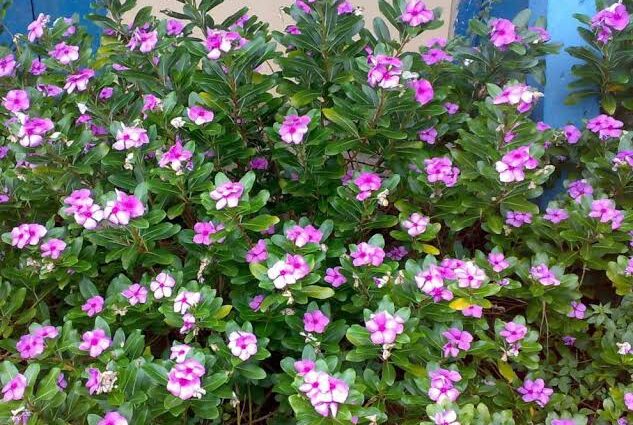In farming, the trend of medicinal crops among farmers is increasing rapidly. Because in today’s modern era, there is a very high demand for medicinal crops in the markets. This is why today, farmers are earning very good profits from the production of these crops according to the market demand. Moreover, if you are also a farmer planning to grow medicinal crops, then we are giving you information about one such crop, Sadabahar. By Sadabahar cultivation, you can earn a lot from its flowers, leaves and stems. The other name of this medicinal crop is Periwinkle. Moreover, it is an important plant for its medicinal properties. Sadabahar is a perennial and important medicinal herb commonly used as an ornamental plant.
Introduction to Sadabahar
Sadabahar’s botanical name is Catharanthus roseus. It is an evergreen herb, also known as Sadaphuli, in India. Moreover, this plant is native to Madagascar on the African continent and grows wild in the tropical rainforest. It is known by numerous names in various regions of India, such as Sudukadu Mallikai in Tamil, Nayantara or in Bengali, Ushamalari in Malayalam, Ratanjot in Punjabi and Apanskanti in Oriya. Its leaves are bright, whose shape varies from oval to oblong, the vein between them is yellow, and the size of the leaves is small.
Moreover, its flowers have 5 petals, and in the middle is a yellow-pink or purple-coloured eye. Medicines prepared from this plant treat many diseases like leukaemia and cancer. Its crop is grown all over India.
Sadabahar Species
There are three species of common evergreen. There are pink petals, white petals, pink, purple and velvety in the middle of white flowers. These species are grown as medicinal plants.
Sadabahar Cultivation In India
Suitable Climate And Soil For Sadabahar
A tropical climate is suitable for Sadabahar cultivation. Its higher yield is found in hot and high-humidity conditions. Temperature ranging from 15 to 25 degrees centigrade is considered better for its growth. It can be planted from September to February. Furthermore, it can be easily grown in areas with rainfall up to 100 cm with the help of a New Holland tractor. It can also be grown in infertile soil. More fertile soil is not very good for its production, as it damages the plant’s flowers. Moreover, it can be cultivated easily in any soil with good drainage. For this, the soil pH range should be 6 to 6.5.
Sadabahar Cultivation Field Preparation
There is no requirement to prepare the soil in any special way for Sadabahar cultivation. But for commercial farming, prepare its field in August. Then, after two to three deep ploughing with a Swaraj tractor, put about 15 tonnes of rotten cow dung manure per hectare in the field, plough again, and mix the cow dung manure in the soil. Then, water should also be applied according to the convenience of farming.
Fertilizer Needs
According to experts, use seeds up to one year old for a good yield of Sadabahar. Its cultivation is done from the plants prepared in the nursery. Apart from this, its sowing is done directly through the medium of seeds. About 2.5 kg of seed is required for one hectare. For shifting farming, seedlings of 500 grams of seeds are raised in nursery beds, which are suitable for 1 hectare. Transplant its preparation in the field, keeping a distance of 45 cm from line to line and 30 cm from plant to plant. In this way, about 74000 plants are grown in a 1-hectare field.
Give 26 kg Nitrogen, 13 kg Phosphorous and 13 kg Potash at the time of transplanting of its plants. Rest quantity should be given in 2 parts, i.e. after 45 days and 90 days after sowing. Moreover, trials conducted in Delhi have shown that 80 kg of nitrogen per hectare is beneficial for irrigated fields and 40 kg of nitrogen per hectare for non-irrigated fields, which depend on rain.
Plant Care In Sadabahar Cultivation
Irrigation
First, irrigation should be done immediately after transplanting. After this, irrigate regularly for 15-15 days. Irrigation is not required when the rainy season starts. After this, water according to the moisture in the winter days. After the crop is 3 months old, apply regular irrigation at an interval of 15-20 days.
Weeding
If weeds are high in the field, then do regular weeding. Moreover, its field should be made weed free by weeding after every month, and the crop should be weeded 2-5 times.
Sadabahar Cultivation Yield
According to experts, the entire crop of Sadabahar is fully prepared for yielding in about 8 to 10 months. As the plant develops after transplanting, at the same time, alkaloids and other chemicals also grow inside it. In the crop of 6 to 8 months, the Vincristine element is found maximum in the roots. Because of this, the old roots can be plucked for the first time. After this, the roots can be broken again after 3 months. Plucking leaves can also be done 2-4 times within 6 to 8 months. According to experts, about 3.6 tonnes of dry leaves and 1.5 tonnes of dry roots and 4.5 tonnes of stems per hectare can be obtained from its plant. Its roots are sold in the market at a good price. Apart from this, its stem, root and all parts are used in the market, so the profit is more.
Stay tuned with us for more details about profitable flower farming.

